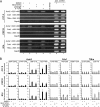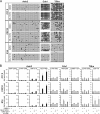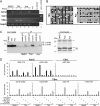Differential control of Wnt target genes involves epigenetic mechanisms and selective promoter occupancy by T-cell factors
- PMID: 17923689
- PMCID: PMC2169180
- DOI: 10.1128/MCB.00555-07
Differential control of Wnt target genes involves epigenetic mechanisms and selective promoter occupancy by T-cell factors
Abstract
Canonical Wnt signaling and its nuclear effectors, beta-catenin and the family of T-cell factor (TCF) DNA-binding proteins, belong to the small number of regulatory systems which are repeatedly used for context-dependent control of distinct genetic programs. The apparent ability to elicit a large variety of transcriptional responses necessitates that beta-catenin and TCFs distinguish precisely between genes to be activated and genes to remain silent in a specific context. How this is achieved is unclear. Here, we examined patterns of Wnt target gene activation and promoter occupancy by TCFs in different mouse cell culture models. Remarkably, within a given cell type only Wnt-responsive promoters are bound by specific subsets of TCFs, whereas nonresponsive Wnt target promoters remain unoccupied. Wnt-responsive, TCF-bound states correlate with DNA hypomethylation, histone H3 hyperacetylation, and H3K4 trimethylation. Inactive, nonresponsive promoter chromatin shows DNA hypermethylation, is devoid of active histone marks, and additionally can show repressive H3K27 trimethylation. Furthermore, chromatin structural states appear to be independent of Wnt pathway activity. Apparently, cell-type-specific regulation of Wnt target genes comprises multilayered control systems. These involve epigenetic modifications of promoter chromatin and differential promoter occupancy by functionally distinct TCF proteins, which together determine susceptibility to Wnt signaling.
Figures







References
-
- Arce, L., N. N. Yokoyama, and M. L. Waterman. 2006. Diversity of LEF/TCF action in development and disease. Oncogene 25:7492-7504. - PubMed
-
- Arias, A. M., and P. Hayward. 2006. Filtering transcriptional noise during development: concepts and mechanisms. Nat. Rev. Genet. 7:34-44. - PubMed
-
- Arnold, S. J., J. Stappert, A. Bauer, A. Kispert, B. G. Herrmann, and R. Kemler. 2000. Brachyury is a target gene of the Wnt/beta-catenin signaling pathway. Mech. Dev. 91:249-258. - PubMed
Publication types
MeSH terms
Substances
LinkOut - more resources
Full Text Sources
Other Literature Sources
Molecular Biology Databases
